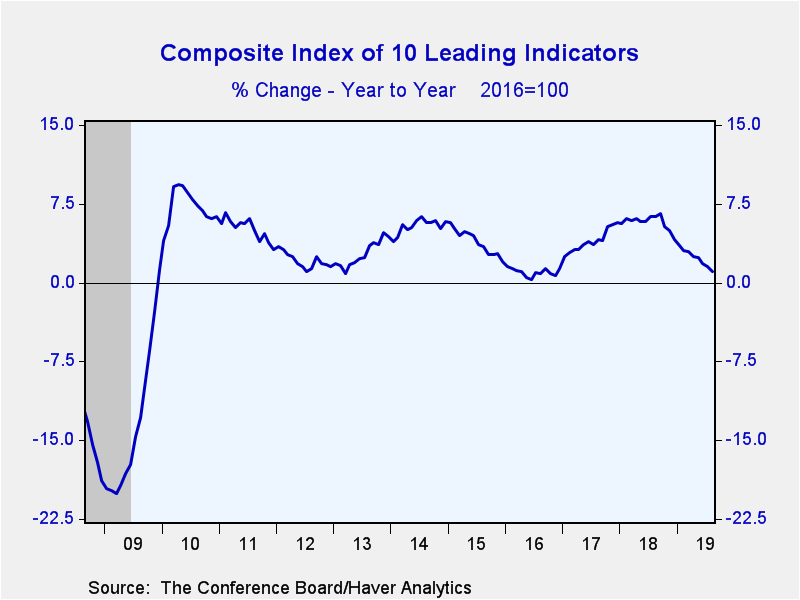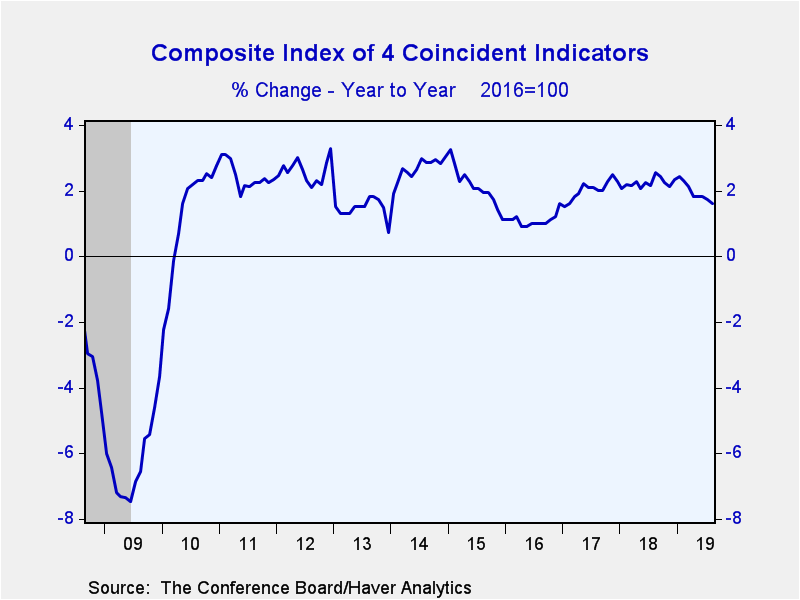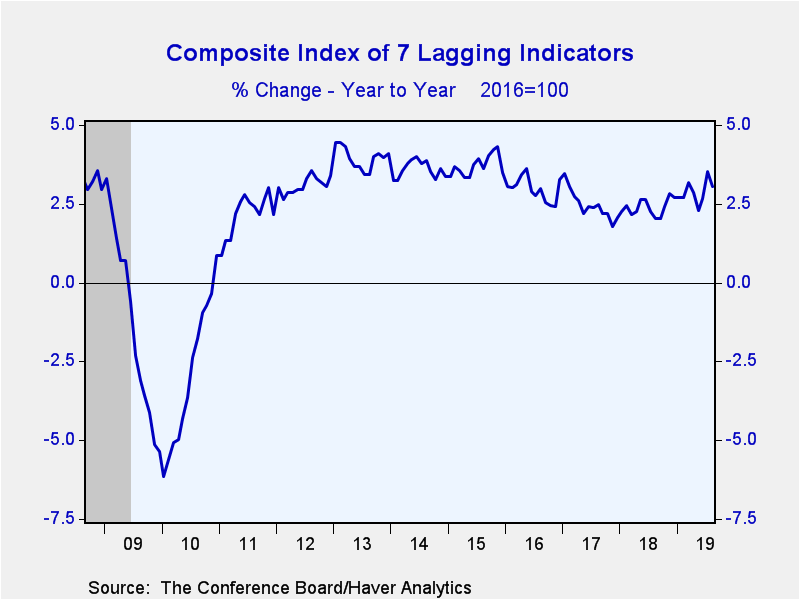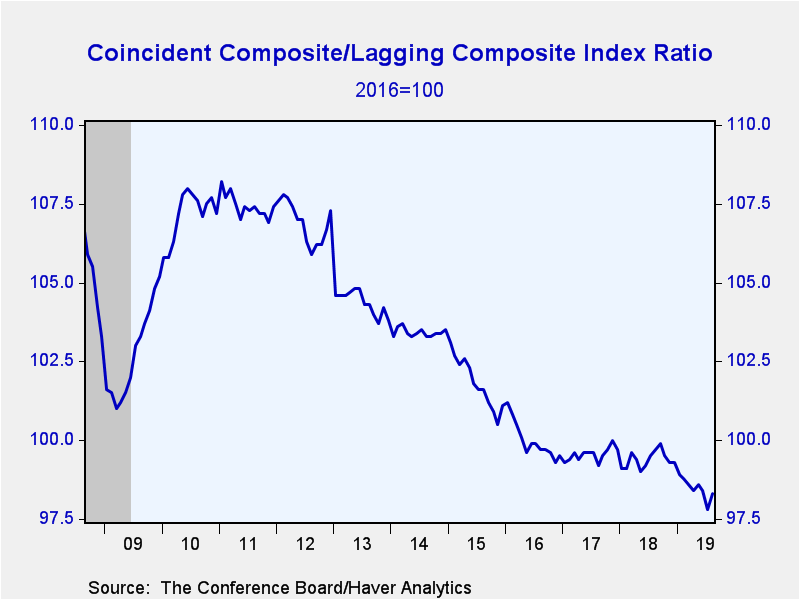 Global| Sep 19 2019
Global| Sep 19 2019U.S. Leading Economic Indicators Hold Steady
by:Tom Moeller
|in:Economy in Brief
Summary
The Conference Board's Composite Index of Leading Economic Indicators was unchanged during August (1.1% y/y) following a 0.4% July increase, revised from 0.5%. The index has been trending sideways since late-last year. A 0.1% increase [...]
The Conference Board's Composite Index of Leading Economic Indicators was unchanged during August (1.1% y/y) following a 0.4% July increase, revised from 0.5%. The index has been trending sideways since late-last year. A 0.1% increase had been expected in the Action Economics Forecast Survey. The series is comprised of 10 components which tend to precede changes in the overall economy.
Performance amongst the components of the Leading Indicator index was decidedly mixed in August. Contributing positively to the index were the readings for building permits, the average workweek, factory orders for consumer goods, consumer expectations for business/ economic conditions and the leading credit index. Offsetting these increases were initial claims for jobless insurance, the ISM new orders index, stock prices and the yield spread between 10-year Treasuries & Fed Funds. Factory orders for nondefense capital goods held steady.
Three-month growth in the leading index of 1.4% (AR) remained below the high of 9.1% in December 2017.
The Index of Coincident Economic Indicators increased 0.3% (1.6% y/y) during August following no change in July, revised from 0.2%. The rise reflected increases in each of the component series: personal income less transfer payments, nonagricultural payroll employment, industrial production and manufacturing & trade sales.
Three-month growth in the coincident index improved to 2.3% (AR) from a low of 0.4% in April and May.
The Index of Lagging Economic Indicators fell 0.3% (+3.0% y/y) in August following an unrevised 0.6% July increase. It was the first decline in three months. The average duration of unemployment retraced its July rise. The prime rate, the business I/S ratio and growth in factory sector unit labor costs also fell. Offsetting these declines were gains in the services CPI, the ratio of consumer credit outstanding-to-personal income and growth in C&I loans outstanding.
Three-month growth in the lagging index eased to 3.4%, but remained up from growth of 1.1% in May.
The ratio of coincident-to-lagging economic indicators is sometimes considered a leading indicator of economic activity. It rose slightly from July which was nearly the lowest level since early-1975.
The Conference Board figures are available in Haver's BCI database; the components are available there, and most are also in USECON. The expectations are in the AS1REPNA database. Visit the Conference Board's site for coverage of leading indicator series from around the world.
| Business Cycle Indicators (%) | Aug | July | June | Aug Y/Y | 2018 | 2017 | 2016 |
|---|---|---|---|---|---|---|---|
| Leading | 0.0 | 0.4 | 0.0 | 1.1 | 5.7 | 4.0 | 1.0 |
| Coincident | 0.3 | 0.0 | 0.3 | 1.6 | 2.2 | 2.0 | 1.1 |
| Lagging | -0.3 | 0.6 | 0.5 | 3.0 | 2.4 | 2.5 | 3.0 |
Tom Moeller
AuthorMore in Author Profile »Prior to joining Haver Analytics in 2000, Mr. Moeller worked as the Economist at Chancellor Capital Management from 1985 to 1999. There, he developed comprehensive economic forecasts and interpreted economic data for equity and fixed income portfolio managers. Also at Chancellor, Mr. Moeller worked as an equity analyst and was responsible for researching and rating companies in the economically sensitive automobile and housing industries for investment in Chancellor’s equity portfolio. Prior to joining Chancellor, Mr. Moeller was an Economist at Citibank from 1979 to 1984. He also analyzed pricing behavior in the metals industry for the Council on Wage and Price Stability in Washington, D.C. In 1999, Mr. Moeller received the award for most accurate forecast from the Forecasters' Club of New York. From 1990 to 1992 he was President of the New York Association for Business Economists. Mr. Moeller earned an M.B.A. in Finance from Fordham University, where he graduated in 1987. He holds a Bachelor of Arts in Economics from George Washington University.










